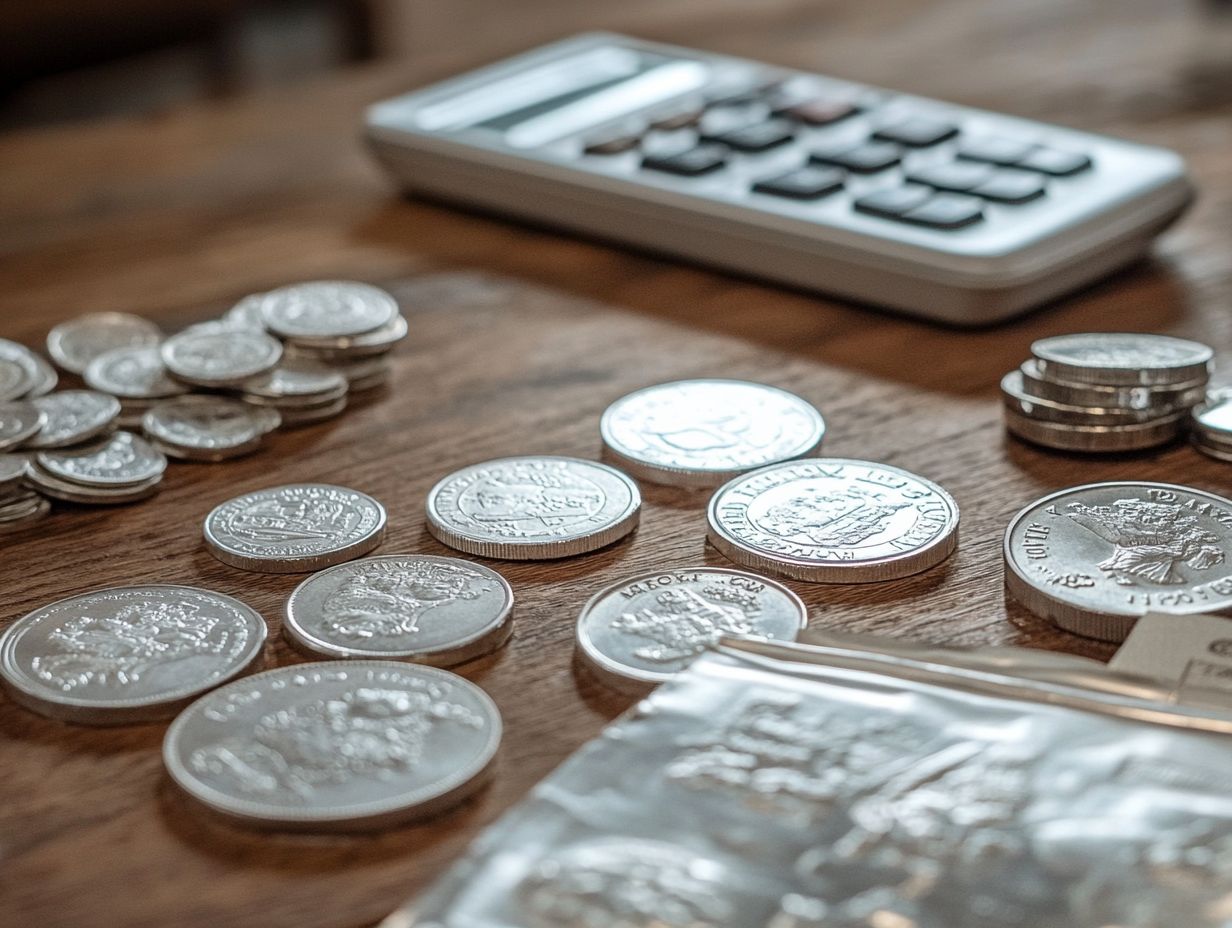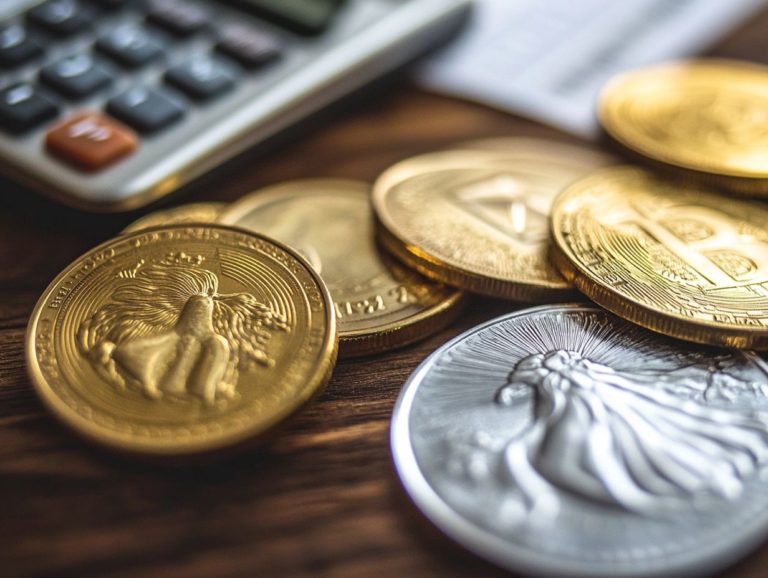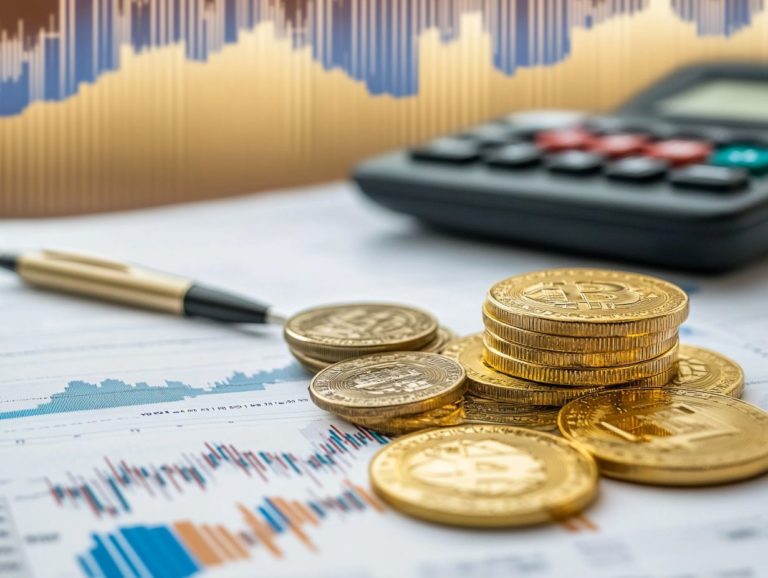The Impact of Tax Changes on Silver Investments
Understanding silver investments can be complex, particularly with recent tax changes that may influence your strategy.
This overview explains how these tax shifts impact those investing in the silver market. It explores effective tax planning techniques aimed at maximizing returns while minimizing liabilities.
It also discusses the benefits of silver as a hedge against inflation and the associated risks, such as market volatility.
Get ready to gain the knowledge you need to make informed investment decisions.
Contents
- What You Should Know:
- Overview of Tax Changes
- How Tax Changes Affect Silver Investments
- Strategies for Managing Taxes on Silver Investments
- Potential Benefits of Investing in Silver
- Risks and Considerations for Silver Investments
- Frequently Asked Questions
- What are the current tax policies for silver investments?
- How do tax changes impact silver investments?
- Are there any tax-free options for silver investments?
- Do tax changes affect silver investments differently from other investments?
- What is the best way to mitigate the impact of tax changes on silver investments?
- Is it recommended to make changes to silver investments based on potential tax changes?
What You Should Know:
- Stay updated on tax laws to protect your silver investment profits.
- Use smart tax strategies to keep more money in your pocket.
- Understand the risks of silver investments alongside their benefits.
Overview of Tax Changes
In 2023, tax changes are significantly affecting how you invest in precious metals, including gold and silver. Knowing the tax implications is crucial for your investment strategy.
These changes reflect economic uncertainty. Smart tax planning helps you reduce your tax liability and meet reporting requirements.
Explanation of Recent Tax Changes
Recent tax changes impact how capital gains are classified, affecting how you report your earnings from silver and gold investments. You should carefully evaluate your strategies to navigate the updated reporting requirements.
The changes in tax classification may lead you to reconsider your holding periods, as longer-term investments often yield more favorable rates compared to frequent trading. This reevaluation is vital for optimizing returns while minimizing tax liabilities.
How Tax Changes Affect Silver Investments
Recent tax changes impact silver investments, especially how the IRS views these assets in terms of capital gains.
As a silver investor, whether you’re holding physical assets like coins and bars or other forms, you must understand the intricate tax implications associated with collectibles and investment profits.
Implications for Investors
The recent tax changes bring higher tax liabilities and stricter reporting requirements. You need to understand IRS regulations to navigate these changes.
If you’re involved in precious metals IRAs, the increased scrutiny makes it essential to stay updated on any new forms or documentation required. You now bear the responsibility of ensuring accurate reporting to avoid costly penalties.
Increased tax liabilities may influence your investment strategies, prompting a review of your current holdings in silver and other precious metals.
By grasping how these regulations apply to your investments, you can make informed decisions that safeguard your financial future in the unpredictable realm of precious metals.
Strategies for Managing Taxes on Silver Investments
Implementing effective strategies for managing taxes on your silver investments can greatly reduce your tax liability and improve your overall investment returns. This makes tax planning an essential element of your investment strategy.
Tax Planning and Mitigation Techniques
Tax planning and mitigation techniques for your silver investments require a strategic mindset to effectively manage capital losses while unlocking tax advantages through tax-deferred accounts.
By leveraging individual retirement accounts (IRAs)—a type of savings account that offers tax advantages—or self-directed accounts designed specifically for precious metals, you have the opportunity to significantly reduce your taxable income. This approach allows your silver investments to flourish without the weight of immediate tax burdens.
Understanding the nuances of taxes on profits from selling assets is crucial. Strategies such as offsetting gains with losses can prove beneficial. It’s also wise to consider the timing of your sales. Holding silver for over a year can often lead to better tax rates.
Embracing a holistic strategy paves the way for significant long-term savings and fosters a more efficient investment portfolio.
Potential Benefits of Investing in Silver
Investing in silver can bring you many exciting benefits! Not only does it serve as a robust hedge against inflation, but it also adds valuable diversification to your investment portfolio.
This strategy can unlock amazing growth opportunities for your investments over time.
Diversification and Inflation Hedge
Diversifying through silver investments serves as a powerful inflation hedge, offering you a buffer against market volatility while enhancing the overall stability of your portfolio.
As inflation threatens to erode your purchasing power and introduces uncertainty into financial markets, incorporating precious metals like silver into your investment strategy becomes increasingly vital. By allocating a portion of your assets to silver, you’re tapping into a historically resilient asset class.
In periods of economic turbulence, silver tends to hold its value or even appreciate, acting as a safeguard against the declines often experienced in traditional equities and bonds. This kind of diversification allows you to distribute risk effectively, ultimately leading to a more balanced and robust investment portfolio.
Risks and Considerations for Silver Investments
Silver investments present enticing benefits, but they also come with inherent risks that you must carefully weigh. Market volatility and liquidity challenges can pose significant hurdles, especially during periods of economic uncertainty.
Being aware of these factors will help you navigate the complexities of silver investing with greater confidence.
Market Volatility and Liquidity
Market volatility plays a crucial role in the liquidity of your silver investments, creating challenges if you’re looking to maximize your returns in ever-changing economic conditions.
This complex relationship is shaped by a range of economic factors, including interest rates, inflation, and geopolitical events that influence market sentiment. When uncertainty strikes, the demand for silver can fluctuate significantly, impacting its market price and the ease with which you can buy or sell your assets.
In these times, grasping the intricacies of market dynamics is essential for making well-informed decisions. Recognize that while volatility can open doors to new opportunities, it also necessitates a careful evaluation of liquidity conditions to protect your investments amidst the ebb and flow of the market.
Frequently Asked Questions
What are the current tax policies for silver investments?
The current tax policies for silver investments vary depending on the type of investment, such as physical silver, silver ETFs, or silver stocks. Generally, silver investments are subject to capital gains taxes at the federal level, with some states also imposing their own taxes.
Ready to dive into silver investing? Consult with a financial advisor for personalized strategies!
How do tax changes impact silver investments?
Tax changes can significantly impact silver investments. They can influence profitability and overall returns.
For instance, an increase in capital gains tax rates can reduce the net profit from selling silver. Conversely, a decrease in rates can lead to larger profits.
Are there any tax-free options for silver investments?
Yes, some tax-free options exist. You can invest in a Roth IRA or a self-directed IRA.
These retirement accounts allow your silver investments to grow without taxes on profits until retirement age.
Do tax changes affect silver investments differently from other investments?
Yes, silver investments may be impacted differently due to their status as precious metals. They might have different tax rates or exemptions compared to stocks or real estate.
What is the best way to mitigate the impact of tax changes on silver investments?
Consulting a financial advisor or tax professional can help create a tax-efficient investment strategy. Diversifying your investments across various types of silver assets can also minimize tax impacts.
Is it recommended to make changes to silver investments based on potential tax changes?
Don’t rush into changes based on potential tax shifts! It’s essential to focus on your long-term goals and seek professional advice before altering your investment portfolio.


















